Sabre

SABRE (Source Area in situ BioREmediation) was a collaborative R&D project undertaken by an international, multidisciplinary team which ran between 2004 and 2008. The project comprised laboratory and field-pilot scale development of an accelerated anaerobic bioremediation process for free-phase chlorinated solvent contamination in groundwater. Quantitative performance validation of the SABRE field study, to assess remediation efficiency, entailed detailed monitoring, numerical modelling and statistical analysis. A UK test site contaminated with trichloroethene (TCE) was used to undertake the project, which is supported through the UK DTI Bioremediation LINK programme.

Why chlorinated solvents?
Chlorinated solvents have been used in large quantities by a diverse range of industries (including chemicals production, metalworking, automotive, aerospace, electronics and dry cleaning). They are consequently extremely common contaminants in soil and groundwater.
Chlorinated solvent releases into the sub-surface may result in the presence of free-phase (dense non-aqueous phase liquid; DNAPL) chlorinated solvent contamination, which will persist for decades and act as long-term sources of groundwater contamination.
The Bioremediation Process
Bioremediation is the application of biological degradation processes to reduce the amount of contamination present in the subsurface (soil or groundwater) and/or the risks posed by such contamination.
Under anaerobic (oxygen-free) conditions, the process of dehalorespiration undertaken by specific bacteria can result in the complete degradation of many specific chlorinated solvents to innocuous end-products. This biodegradation process can also take place even when chlorinated solvent DNAPL is present.
The SABRE project comprises laboratory and field-pilot scale development of an accelerated anaerobic bioremediation process for DNAPL source areas in soil and groundwater based upon use of dehalorespiring bacteria. Treatment is achieved by the controlled addition of growth substrates to support dehalorespiring bacteria under conditions that ensure the maximum rate of reductive dechlorination. The process offers the potential to be a technically and economically effective in situ remediation option for soil and groundwater contaminated with large amounts of chlorinated solvents.
Dehalorespiration is the deliberate use by certain bacteria of chlorinated solvents and other compounds as their respiratory substrate (terminal electron acceptor) under anaerobic (oxygen-free) conditions. These dehalorespiring bacteria form part of the natural microbial community that can develop in environments where chlorinated solvents are present and conditions suitable for their growth. Dehalorespiration brings about a step-wise removal of chlorine atoms from the chlorinated solvent molecule and can yield a fully dechlorinated product, for example: trichloroethene (TCE) is converted through cis-1,2-dichloroethene (DCE) and vinyl chloride (VC) to ethene.

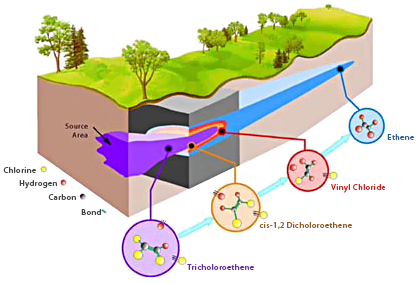
Project SABRE
The objective of Project SABRE was to generate scientifically robust, multiple lines of evidence to enable:
- Development of this novel in situ anaerobic bioremediation process with particular emphasis on the use of partitioning substrates, the benefit of bioaugmentation and maximising process performance.
- Demonstration of process application in field-pilot test cells.
- Development of applicable and cost-effective site investigation and monitoring techniques for this and related bioremediation technologies.
- Evaluation of cost-effective process configurations for wider field application of the technology, subject to further development.
- Modelling to support data interpretation and future development.
- Dissemination to facilitate uptake of the technology by consultants, regulators and end-users.
- Development of intellectual property in the form of know-how and techniques that will be subject to exploitation through appropriate mechanisms.
The project ran from October 2004-2008 and involved the following work packages: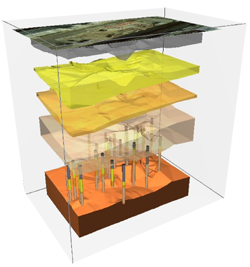
-
Site investigation. To characterise the test area, provide design information for the field-scale process and determine the initial quantity of contamination.
-
Microbiology. Use of laboratory microcosm and column tests to determine the optimal conditions for the bioremediation process. Application of microbiological and molecular biological techniques for process monitoring.
-
Test cell design, installation and operation. Design, engineering and installation of two field-pilot scale test areas suitable for technology demonstration and the development of design criteria for future routine technology application. Operation of these in response to data obtained.
-
Performance assessment. Monitoring of the process by traditional and novel geophysical techniques and evaluation of the data collected.
-
Flow and process modelling. For process design and the development of tools to aid in interpretation of results and for future technology implementation.
-
Technical quality management. Ensuring that the data collected are robust and statistically valid. A Scientific Advisory Group was appointed to help guide the project and ensure the highest scientific standards are maintained.
-
Dissemination.
-
Project management.
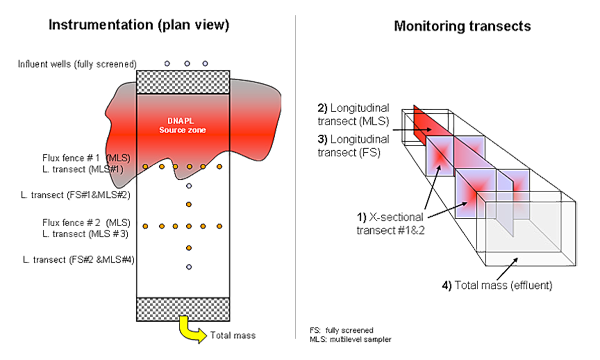
Project activities
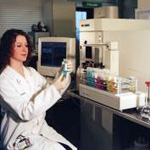 Laboratory studies were used to determine appropriate process conditions for effective DNAPL bioremediation at the test site and to generate design data for the field pilot-scale treatment test. In view of the properties of DNAPL, specific consideration was given to the use of substrate formulations that partition into the organic DNAPL phase and were subsequently slowly released to support biodegradation at the around the DNAPL source.
Laboratory studies were used to determine appropriate process conditions for effective DNAPL bioremediation at the test site and to generate design data for the field pilot-scale treatment test. In view of the properties of DNAPL, specific consideration was given to the use of substrate formulations that partition into the organic DNAPL phase and were subsequently slowly released to support biodegradation at the around the DNAPL source.
Field pilot-scale studies were undertaken in two closely coordinated test cells: one contained cell (contained by use of sheet piles) that enabled intensive control and monitoring of the treatment process and one uncontained unit that represented a practical model of how such a process could be cost-effectively implemented at further sites.
The development of any bioremediation technology requires a high level of confidence in the field performance of the process if it is to gain acceptance. For DNAPL remediation, this need is greater due to the complexity of source areas, the difficulty in demonstrating performance of existing competing technologies, and their ineffectiveness. The contained field pilot test cell was intensively monitored by traditional and novel chemical, biological and geophysical techniques, supported by statistical data processing and interpretation. The uncontained pilot test area were operated using information generated in the contained cell but in a way that was representative of non-research operational constraints.
Modelling was applied in the design and validation of the process and provided essential information and tools to enable future application. In this way, SABRE was able to identify the best implementation approaches for the technology to take forward for further development. Dissemination of the learning obtained throughout the project was a key objective of SABRE and an intensive communication plan has been developed. As a member of the SABRE team, CL:AIRE played a major role in the dissemination process, which included:
- Technical updates issued through CL:AIRE and other channels.
- Technical papers in peer-reviewed scientific papers.
- Presentations at major international scientific conferences.
- Presentation of a final project report issued through CL:AIRE.
- An end-of-project scientific conference.
- Development and publication of a Technology Guidance Document on the selection, implementation, design, operation and monitoring of DNAPL bioremediation, incorporating the learning from SABRE and best practices from elsewhere.
- Development and presentation of a training course on accelerated anaerobic bioremediation based upon the Technology Guidance Document.
The Scientific Advisory Group (SAG)
The SAG comprised of three independent internationally renowned specialists in chlorinated solvent behaviour and remediation who provided guidance to the project and peer reviewed to ensure that the highest possible scientific standards were maintained. The SAG comprises:
- Dr Mike Larkin, Queen’s University Belfast , UK
- Dr Perry McCarty, Stanford University , USA
- Dr Mike Rivett, University of Birmingham, UK
2009
SABRE Conference and Dissemination Workshop, The Barbican Centre, London, UK, October 2009
The SABRE Project Partners presented the current state-of-the-art in effective ISB of DNAPL source zones, based on the experiences of the completed SABRE Project. The conference provided the research community, regulators, stakeholders, and practitioners with the scientific background and detailed technical knowledge that underpins the use of ISB for DNAPL source zones.
Immediately following the London conference,a 1-day training more specific Dissemination Workshop was convened in London which provided instruction for practitioners to understand and implement the enhanced ISB for treatment of chlorinated ethene DNAPL source zones.
SABRE Annual Technical Meeting, British Geological Survey, Keyworth, UK, June 2009
Over the 22nd-24th June, the SABRE Project Partners met at the Annual Technical Meeting and discussed the post-operational results from the cell. This concluded with a strategy for dissemination of the project findings and the concept of SABRE 2 was discussed (watch this space!).
Test Cell Pumps turned off & Post-Treatment Site Investigation Commencement, January 2009
On Monday 5th January the pumps in the test cell were turned off and removed. This marked the end of the test cell operation. Removal of the pumps allowed much easier access to the site for drilling the investigation boreholes (to obtain core samples) so drilling was ahead of schedule despite the very cold weather.
2008
Flux Test, Tracer Test and Final Sampling Round all Completed, December 2008
Passive flow meters were installed for a week and then removed. A tracer test using a conservative K-Br tracer was injected over a period of 10 hours and sampled over four weeks; this allowed determination of velocities and dispersivities in the cell and was analysed using a semi-analytical tool.
SABRE Annual Technical Meeting, Toronto, September 2008
Representatives of the SABRE project partners attended the annual technical meeting held in Toronto on 22-25 September 2008. Also present were representatives of the project sponsors and members of the Scientific Advisory Group (SAG). The meeting reviewed in detail the progress made to date and field results coming from the test cell. With valuable review and assistance by the SAG members, the plan for the next period of test cell operation and monitoring was refined, and the plans for dissemination clarified. SABRE would like to thank the University of Toronto for the provision of meeting facilities and for assistance in organising the event.
SABRE session at the Battelle Conference on remediation of Chlorinated and Recalcitrant Compounds, May 2008
A whole session (B1) was devoted to the SABRE project at the Battelle conference on Remediation of Chlorinated and Recalcitrant Compounds, Monterey, California on 19-22 May 2008. Five papers were presented as platform presentations, with the remaining nine as posters (final conference programme). The presentations covered all aspects of the project and included the latest findings from laboratory, field and modelling technical work packages, as well as an overview of the biological treatment of chlorinated solvent DNAPLs.
2007
SABRE Annual Technical Meeting, Washington DC, September 2007
Representatives of the SABRE project partners attended the annual technical meeting held in Washington DC on 18-20 September 2007. Also present were representatives of the project sponsors and members of the Scientific Advisory Group (SAG). The meeting reviewed in detail the progress made to date and field results from the test cell. With valuable review and assistance by the SAG members, the plan for the next period of test cell operation and monitoring was refined. SABRE would like to thank the US National Research Council for the provision of meeting facilities and DuPont for the assistance in organising the event.
Bio-augmentation, May 2007
Bio-augmentation of the SABRE test cell with a KB-1TM culture, supplied by SiREM, commenced on the 14 May 2007. There was an indigenous dehalorespiring microbial population evident, and KB-1TM was being used to stimulate full dechlorination to ethene.
Electron Donor Injection, April 2007
Injection of SRSTM emulsified soya oil, provided by Terra Systems, commenced on 25 April 2007. Injection was completed on the 30 April; a total of 2900 litres of SRSTM was injected, diluted to 5% in groundwater from the test cell.
First set of field samples taken, February 2007
Since starting the cell operation, and after giving the hydraulic system time to settle, the first set of groundwater samples was taken. Samples were analysed for TCE, DCE, VC, ethane and ethane; also selected major ions and chemical parameters. A further two full sampling rounds are scheduled, to establish a baseline, before electron donor injection. Meanwhile, weekly measurements of field pH, EC, ORP, DO and temperature were scheduled.
SABRE cell flow system started up, January 2007
Abstraction started from the test cell at 17.15 on Monday 8 January 2007. The pumps continued to run throughout the Baseline and Operational periods to ensure that a constant hydraulic gradient was applied across the cell, which was approximately equal to the average hydraulic gradient outside the cell. The set flow rate of 1.4 litres per minute corresponded to a flushing rate of approximately one cell pore volume every 40 days.
2006
SABRE Annual Technical Meeting, London, September 2006
Representatives of the SABRE project partners attended the annual technical meeting held in London on 11-13 September. Also present were representatives of the project sponsors and members of the SABRE Scientific Advisory Group (SAG). The meeting reviewed in detail the progress made to date and, with the valuable review and assistance provided by the SAG members, optimised the plan for the next period of test cell operation and the underpinning scientific research and monitoring programmes. On 11 September, the meeting participants were kindly hosted by Mr Alan Whitehead MP, co-chair of the Parliamentary Waste Group, at a dinner held at the Houses of Parliament, attended by a number of invited guests. The SABRE team would like to thank Shell Global Solutions for the provision of meeting facilities and CL:AIRE for the assistance in organising the event.
SABRE schedules multiple presentations at the Battelle conference on Remediation of Chlorinated and Recalcitrant Compounds, May, 2006.
The SABRE project team presented a total of 12 papers and posters at the Battelle conference on Remediation of Chlorinated and Recalcitrant Compounds, Monterey, California on 22-25 May 2006.
Four of the papers were presented as platform presentation, with the remaining nine provided as posters. The presentations covered all aspects of the project and included the latest findings from each of the technical work packages, as well as providing a co-ordinating overview of the status of the project.
To help the scientific community identify the SABRE presentations, the project team prepared a SABRE project brochure for the occasion that a timetable for the presentations and a summary of the project objectives is provided.
Field test cell installation complete, March 2006.
The SABRE project field test cell installation was completed in March 2006. Constructed of glass reinforced plastic (GRP) sheet piles to allow the application of innovative monitoring techniques, the test cell enabled close process control and intensive monitoring to demonstrate the performance of the bioremediation process.
2005
SABRE first annual Project Management Team technical meeting held, September 2005.
The first of the scheduled annual SABRE Project Management Team technical meetings was held on the 26-28 September 2005. Kindly hosted by the University of Edinburgh, UK, the meeting was attended by an invited group of over 40 people, including representatives of all partner organisations, the full Scientific Advisory Group and observer delegates from the LINK programme, the Environment Agency and US Environmental Protection Agency.
As well as reviewing technical progress made to date, the meeting reviewed and agreed adjustments to the technical programme based on the data obtained.
Microbiology work package makes excellent progress.
 A recent technical update from the SABRE microbiology work package team on their laboratory microcosm studies has reported effective biodegradation of chlorinated solvent contamination in samples collected from the test site. Complete degradation of the trichloroethene contamination to ethene was observed and detailed statistical analysis applied to establish the most effective materials to be applied in the field-pilot scale testing and provided vital final design information for these.
A recent technical update from the SABRE microbiology work package team on their laboratory microcosm studies has reported effective biodegradation of chlorinated solvent contamination in samples collected from the test site. Complete degradation of the trichloroethene contamination to ethene was observed and detailed statistical analysis applied to establish the most effective materials to be applied in the field-pilot scale testing and provided vital final design information for these.
The team continued with their planned laboratory column test data to provide data that will not only assist the routine operation of the field-pilot test cells but also helped the scientific understanding of the process.
A CL:AIRE technical bulletin titled “Project SABRE Progress Report: Results of a Laboratory Microcosm Study to Determine the Potential for Bioremediation of Chlorinated Solvent DNAPL Source Areas” is now available which summarises the findings.
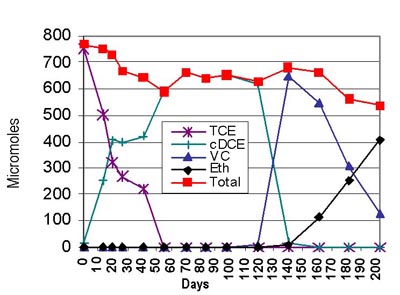
Site Investigation work package delivers initial characterisation of the DNAPL source zone(s)

It is widely recognised that the successful restoration of DNAPL source zones is often limited by inability to adequately describe the subsurface geology in order to predict mass distribution and contaminant mobility, and to select and assess the performance of a specific remediation technology. The SI work package employed a staged approach to quantify the pre- and post-treatment DNAPL source zone characteristics.
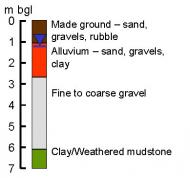 Initial studies from the SI work package detailed the characteristics of the DNAPL source zone at the SABRE site. Activities included i) a review of the historical site data which was used to guide the intrusive site investigation and ii) the application of multiple lines of evidence to determine the spatial distribution of DNAPL in a shallow alluvial setting. Unique individual DNAPL zones (IDZs) were proposed, where distinct contaminant characteristics separate adjacent regions. Contaminant mass was estimated in each of the IDZs. The combined datasets were then used to determine the location and orientation of the contained experimental cell. The initial best estimate of DNAPL mass in the contained cell was in the region of 0.8-1.3 tonnes of DNAPL, equivalent to three to four 200 litre drums of TCE.
Initial studies from the SI work package detailed the characteristics of the DNAPL source zone at the SABRE site. Activities included i) a review of the historical site data which was used to guide the intrusive site investigation and ii) the application of multiple lines of evidence to determine the spatial distribution of DNAPL in a shallow alluvial setting. Unique individual DNAPL zones (IDZs) were proposed, where distinct contaminant characteristics separate adjacent regions. Contaminant mass was estimated in each of the IDZs. The combined datasets were then used to determine the location and orientation of the contained experimental cell. The initial best estimate of DNAPL mass in the contained cell was in the region of 0.8-1.3 tonnes of DNAPL, equivalent to three to four 200 litre drums of TCE.
The SI team applied novel approaches to evaluate uncertainty in the predictions of DNAPL source mass distribution.
CL:AIRE PUBLICATIONS
SABRE Bulletin 1 - Project SABRE (Source Area BioRemediation) – an Overview>>>
SABRE Bulletin 2 - Site Investigation Techniques for DNAPL Source and Plume Zone Characterisation>>>
SABRE Bulletin 3 - Results of laboratory column studies to determine the potential for bioremediation of chlorinated solvent DNAPL source areas>>>
SABRE Bulletin 4 - Insights and modelling tools for designing and improving chlorinated solvent bioremediation applications>>>
SABRE Bulletin 5 - Overview of the SABRE field tests>>>
SABRE Bulletin 6 - Source Area DNAPL Bioremediation: Performance Monitoring and Assessment>>>
Click here to view the full CL:AIRE Library>>>
OTHER PUBLICATIONS
2008
Brovelli, A., et al., 2008, Optimization of buffer injection for the effective bioremediation of chlorinated solvents in aquifers. Poster Presentation at AGU Fall Meeting, San Francisco, December, 2008
Cai, Z., et al., Increasing Confidence in Treatment Performance Assessment using Geostatistical Methods. Poster Presentation at Battelle Conference on Remediation of Chlorinated and Recalcitrant Compounds, Monterey, USA, May 2008
Column Simulation of Reductive Dechlorination of TCE Around DNAPL Source Zones. Poster Presentation at Battelle conference on Remediation of Chlorinated and Recalcitrant Compounds, Monterey, USA, May 2008
Dworatzek, S., et al., Characterizing the Microbial Community in a TCE DNAPL Site: SABRE Microcosm, Column, and Field Studies. Poster Presentation at Battelle Conference on Remediation of Chlorinated and Recalcitrant Compounds, Monterey, USA, May 2008. Harkness, M., et al., 2008
Harkness, M., et al., 2008. Laboratory Column Studies of TCE Dechlorination in DNAPL and Downgradient Plume Zones. Platform Presentation at Battelle conference on Remediation of Chlorinated and Recalcitrant Compounds, Monterey, USA, May 2008
Kokkinaki A., et al., Multiscale Modeling of Enhanced Anaerobic Bioremediation of Trichloroethene. Platform Presentation at Battelle Conference on Remediation of Chlorinated and Recalcitrant Compounds, Monterey, USA, May 2008
OTHER PUBLICATIONS
2008 (Continued)
Kokkinaki A., et al., Simulation of TCE DNAPL Distribution and TCE Anaerobic Reductive Dechlorination in Soil Columns. Poster Presentation at Battelle Conference on Remediation of Chlorinated and Recalcitrant Compounds, Monterey, USA, May 2008Kouznetsova, I., et al., 2008, Detailed Process Interaction Simulated in TCE DNAPL Bioremediation Column Experiments. Poster Presentation at Battelle Conference on Remediation of Chlorinated and Recalcitrant Compounds, Monterey, USA, May 2008
Kouznetsova, I., et al., 2008, Sensitivity and Laboratory Benchmarking of a Biogeochemical Process Model for Enhanced Anaerobic Dechlorination, Poster Presentation at AGU Fall Meeting, San Francisco, December, 2008
Lelliot, M., et al., 2007. Implications of secondary source zones to aquifer remediation. Poster Presentation at Battelle Conference on Remediation of Chlorinated and Recalcitrant Compounds, Monterey, USA, May 2008
McCarty, P., System Design for Enhanced Biological Treatment of Chlorinated Solvent DNAPL. Platform Presentation at Battelle Conference on Remediation of Chlorinated and Recalcitrant Compounds, Monterey, USA, May 2008
Mack, E., et al., 2008. Effect of Sulfate on Aqueous-phase TCE Dechlorination and Electron Donor Utilization in Laboratory Column Studies. Poster Presentation at Battelle Conference on Remediation of Chlorinated and Recalcitrant Compounds, Monterey, USA, May 2008
OTHER PUBLICATIONS
2008 (Continued)
Rivett, M., et al., Results from the SABRE field pilot test: Multilevel sampler assessment of bioremediation, Battelle 08, 12 May 2008, Poster Presentation at Battelle Conference on Remediation of Chlorinated and Recalcitrant Compounds, Monterey, USA, May 2008Robinson, C., Alkalinity Requirements for Enhanced Anaerobic TCE Dehalogenation, Battelle 08, 15 May 2008, Poster Presentation at Battelle Conference on Remediation of Chlorinated and Recalcitrant Compounds, Monterey, USA, May 2008
Roberts et al., 2008. TCE DNAPL Bioremediation Using Partitioning Electron Donors. Poster Presentation at Battelle Conference on Remediation of Chlorinated and Recalcitrant Compounds, Monterey, USA, May 2008
Wealthall, G., et al., 2008. Advances in DNAPL Source Zone Characterization. Platform Presentation at Battelle Conference on Remediation of Chlorinated and Recalcitrant Compounds, Monterey, USA, May 2008
Wilkinson, P., Chambers, J., Lelliott, M., Wealthall, G. and Ogilvy, R., 2008. Extreme sensitivity of crosshole electrical resistivity tomography measurements to geometric errors. Geophysical Journal International, 173 (1). 49-62 (DOI: 10.1111/j.1365-246X.2008.03725.x)
Zeeb, P., et al., 2008. Results from the SABRE Field Pilot Test: Bioremediation of a TCE DNAPL Source Zone. Presentation at Battelle conference on Remediation of Chlorinated and Recalcitrant Compounds, Monterey, USA, May 2008.
OTHER PUBLICATIONS
2007
Fisher A., et al. Interaction of Emulsified Vegetable Oil with TCE DNAPL during Source Area Bioremediation. Poster Presentation at Battelle Conference on In Situ and On-Site Bioremediation Baltimore, May 2007
Gerhard, J., et al. Modelling the Role of Partitioning Substrates in DNAPL Column Studies, Battelle Conference, Platform Presentation at Battelle Conference on In Situ and On-Site Bioremediation Baltimore, May 2007
Lelliot, M., et al. Implications of secondary source zones to aquifer remediation. GQ 2007
Mack, E., et al. Column Studies Exploring the Effect of Sulfate on Aqueous-phase TCE Dechlorination Efficiency. Presentation at Battelle Conference on In Situ and On-Site Bioremediation Baltimore, May 2007
Morgan, P. Remediation technologies development: Project SABRE , Platform Presentation for Ground Engineering contaminated land conference, March 2007
Mike Rivett, Longitudinal transect monitoring of a TCE DNAPL source undergoing bioremediation: baseline and early remediation data, Poster Presentation at Geological Society Bicentennial Conference, London Sept 2007
OTHER PUBLICATIONS
2007 (Continued)
Robinson, C et al., pH Control for Effective Anaerobic Bioremediation of Chlorinated Solvents, Geological Society Bicentennial Conference, London, Sept 2007Wealthall, G., et al. Detailed longitudinal transect monitoring of a TCE DNAPL source zone undergoing bioremediation: Baseline and early remediation data. Geological Society Bicentennial Conference, London, Sept 2007
Wealthall, G., et al. Quantifying DNAPL source zone distribution for remediation design. Geological Society Bicentennial Conference, London, Sept 2007
Wealthall, G. et al. Quantifying uncertainty in DNAPL source zone mass estimates. GQ2007
White, R. et al. Use of high resolution soil core and aqueous-phase monitoring to investigate TCE biodegradation heterogeneity within a DNAPL source zone area. GQ2007
Zeeb et al., 2007. Performance of the Source Area BioRemediation (SABRE) Field Pilot Study. Presentation at Battelle Conference on In Situ and On-Site Bioremediation Baltimore, May 2007
OTHER PUBLICATIONS
2006
Acheson, C. et al. Metrics of performance for the SABRE microcosm study.Poster presentation at Battelle conference on Remediation of Chlorinated and Recalcitrant Compounds, Monterey, USA, May 2006.
Bell, M. et al., Project SABRE – field-scale demonstration of TCE DNAPL bioremediation. Platform presentation at Battelle conference on Remediation of Chlorinated and Recalcitrant Compounds, Monterey, USA, May 2006.
Dworatzek, S. et al. Characterizing the microbial community in SABRE laboratory studies. Poster presentation at Battelle conference on Remediation of Chlorinated and Recalcitrant Compounds, Monterey, USA, May 2006.
Dworatzek, S. et al. Inhibition of reductive dechlorination by sulfate reduction in microcosms. Platform presentation at Battelle conference on Remediation of Chlorinated and Recalcitrant Compounds, Monterey, USA, May 2006.
Harkness, M. et al. Bench-scale performance of partitioning electron donors for TCE DNAPL bioremediation. Poster presentation at Battelle conference on Remediation of Chlorinated and Recalcitrant Compounds, Monterey, USA, May 2006.
Harkness, M. et al. Multi-lab, statistically-based microcosm study for TCE source zone remediation. Platform presentation at Battelle conference on Remediation of Chlorinated and Recalcitrant Compounds, Monterey, USA, May 2006.
OTHER PUBLICATIONS
2006 (Continued)
Lelliott, M. et al. Remediation limitations due to non-NAPL source zones. Poster presentation at Battelle conference on Remediation of Chlorinated and Recalcitrant Compounds, Monterey, USA, May 2006.
Mao, X. et al. Sensitivity of modelling parameters to the factors controlling anaerobic TCE dechlorination in a comprehensive microcosm study. Poster presentation at Battelle conference on Remediation of Chlorinated and Recalcitrant Compounds, Monterey, USA, May 2006.
Mao, X. et al. Examining the success of TCE-enhanced dissolution and anaerobic dechlorination in column studies via numerical modelling. Poster presentation at Battelle conference on Remediation of Chlorinated and Recalcitrant Compounds, Monterey, USA, May 2006.
Wealthall, G. et al. Predicting DNAPL source zone distribution for remediation design. Poster presentation at Battelle conference on Remediation of Chlorinated and Recalcitrant Compounds, Monterey, USA, May 2006.
Wilson, R. et al. Preliminary assessment of biodegradation performance of a TCE NAPL source. Platform presentation at Battelle conference on Remediation of Chlorinated and Recalcitrant Compounds, Monterey, USA, May 2006.
Zeeb, P. et al. Design of an in-situ containment and test cell for demonstrating source srea bioremediation (SABRE). Poster presentation at Battelle conference on Remediation of Chlorinated and Recalcitrant Compounds, Monterey, USA, May 2006.
OTHER PUBLICATIONS
2005
Gerhard, J. et al. Comprehensive model for the dehalogenaton of chlorinated solvents. EGU conference, Vienna, May 2005.
Gerhard, J. et al. Project SABRE (Source Area BioREmediation): An overview. Groundwater Resources Association of California, DNAPL source zone conference, December 2005.
Mao, X. et al. Model parameter variability for enhanced anaerobic DNAPL bioremediation. AGU Fall Meeting 2005, California USA, December 2005.
Morgan, P. Project SABRE – an introduction. Presentation at CL:AIRE Annual Conference, Birmingham UK, April 2005.
Wealthall G. et al. Characterisation of DNAPL source zones for remediation design and performance assessment. Poster at CONSOIL, Bordeaux, France, October 2005.
Team
The active members of the SABRE project team were:
Commercial partners
- Archon Environmental
- Celanese Acetate
- Chevron
- DuPont
- ESI
- General Electric
- GeoSyntec
- Golder Associates
- Honeywell
- Akzo Nobel
- Scientifics
- Strategic Environmental Research and Development Program (SERDP)
- Shell Global Solutions
- Terra Systems
Research sector partners
New members would be welcome.
A close association is maintained on technical matters with:
Sponsors
 SABRE was supported through the UK DTI Bioremediation LINK programme.
SABRE was supported through the UK DTI Bioremediation LINK programme.
The project is funded by in-kind and direct financial contributions from the project partners and by financial contributions through the LINK programme by:
- BBSRC
- DTI
- Environment Agency
- EPSRC
- NERC


